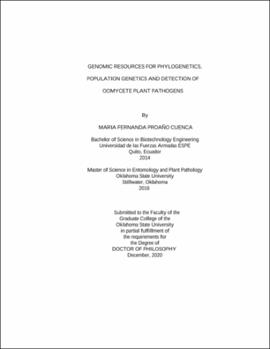| dc.contributor.advisor | Garzon, Carla | |
| dc.contributor.author | Proaño Cuenca, Maria Fernanda | |
| dc.date.accessioned | 2023-04-26T16:20:25Z | |
| dc.date.available | 2023-04-26T16:20:25Z | |
| dc.date.issued | 2020-12 | |
| dc.identifier.uri | https://hdl.handle.net/11244/337472 | |
| dc.description.abstract | Plant pathogenic oomycetes are a diverse group of fungal-like eukaryotes that cause disease in natural and agricultural ecosystems. Due to their biological properties that, in cases, require alternative technologies to culture and study, new methods have been developed. The development of those technologies has driven efforts in basic mycological techniques and genomics, diagnostics, and functional genomics since rapid and robust technologies for accurate identification and characterization are needed to develop and implement effective disease management strategies. My thesis involved integrating plant pathology, genomics, and bioinformatics to explore the evolutionary relationships, population biology, and detection alternatives of important species of the genera Pythium and Globisporangium. Globisporangium irregulare is a complex species that includes G. regulare, G. irregulare sensu stricto (s.s.), G. cryptoirregulare, and G. cylindrosporum. The phylogenomic analysis of the species within the complex conducted found a lack of genealogical concordance under the Genealogical Concordance Phylogenetic Species Recognition (GCPSR) and significant recombination evidence, which supports previous findings that G. cryptoirregulare, G. irregulare s.s. and G. cryptoirregulare are a single species. Later, the population diversity of G. cryptoirregulare in rhododendron from Oregon and Washington was analyzed. It was found that populations displayed a structure mostly associated with clonal lineages maintained in nurseries through the years. Understanding this plant pathogen's diversity and relationships can provide new insights of value for understanding disease epidemiology and disease management. Finally, the EDNA approach implemented through the MiFiTM platform was used to develop a validated database for oomycete diagnostics. It demonstrated its power for the effective detection of oomycete plant pathogens from metasamples. The results of these studies can improve the overall understanding of oomycete pathology and evolution and contribute with information to identify targets for effective and sensitive pathogen detection, allowing accurate and timely disease diagnosis and management. | |
| dc.format | application/pdf | |
| dc.language | en_US | |
| dc.rights | Copyright is held by the author who has granted the Oklahoma State University Library the non-exclusive right to share this material in its institutional repository. Contact Digital Library Services at lib-dls@okstate.edu or 405-744-9161 for the permission policy on the use, reproduction or distribution of this material. | |
| dc.title | Genomic resources for phylogenetics, population genetics and detection of oomycete plant pathogens | |
| dc.contributor.committeeMember | Marek, Stephen | |
| dc.contributor.committeeMember | Walker, Nathan | |
| dc.contributor.committeeMember | Melouk, Hassan | |
| dc.contributor.committeeMember | Hagen, Darren | |
| osu.filename | proanocuenca_okstate_0664d_17004.pdf | |
| osu.accesstype | Open Access | |
| dc.type.genre | Dissertation | |
| dc.type.material | Text | |
| thesis.degree.discipline | Plant Pathology | |
| thesis.degree.grantor | Oklahoma State University | |
